Strategies for Improving Quality of HIV Services in UK
VerifiedAdded on 2023/01/06
|14
|4803
|59
Essay
AI Summary
This essay delves into the crucial topic of improving the quality of HIV services within the UK, emphasizing the significance of comprehensive wellness frameworks encompassing enhanced management, financial strategies, and optimal human resource allocation. The essay examines key quality issues, such as fragmented healthcare experiences, inadequate facilities, and poor patient-provider communication. It explores the evolution of HIV care, highlighting the need for stronger frameworks to address evolving patient needs and the importance of coordinated efforts among healthcare providers, leaders, and affected individuals. The essay reviews literature, including findings from contextual studies and recommendations for improved HIV detection and management. It also discusses quality improvement methods and their impact on patient outcomes, emphasizing the need for a culture of quality and the application of quality improvement practices across all aspects of healthcare provision. The essay concludes by highlighting the importance of ongoing evaluation and improvement to ensure customer satisfaction and loyalty.
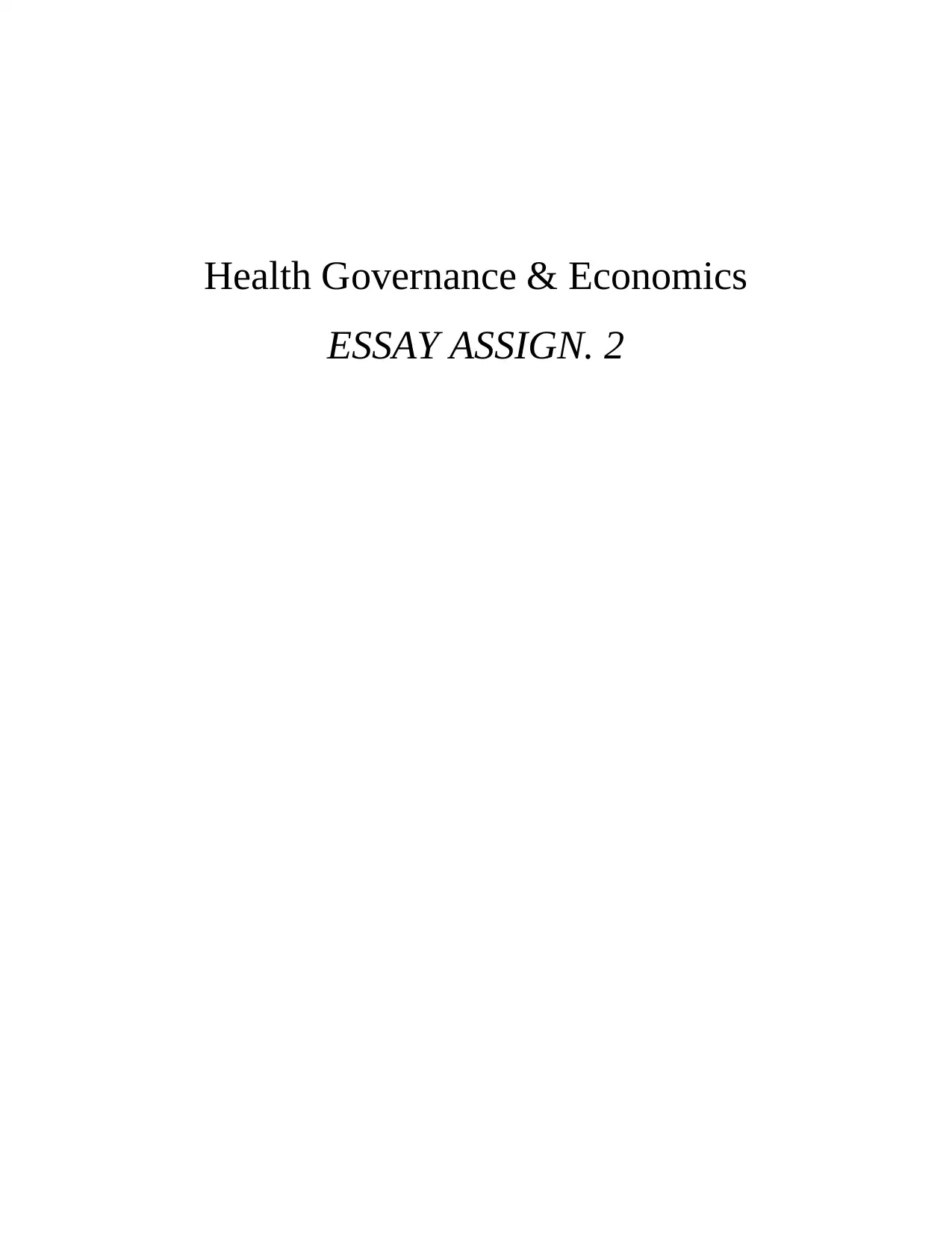
Health Governance & Economics
ESSAY ASSIGN. 2
ESSAY ASSIGN. 2
Paraphrase This Document
Need a fresh take? Get an instant paraphrase of this document with our AI Paraphraser
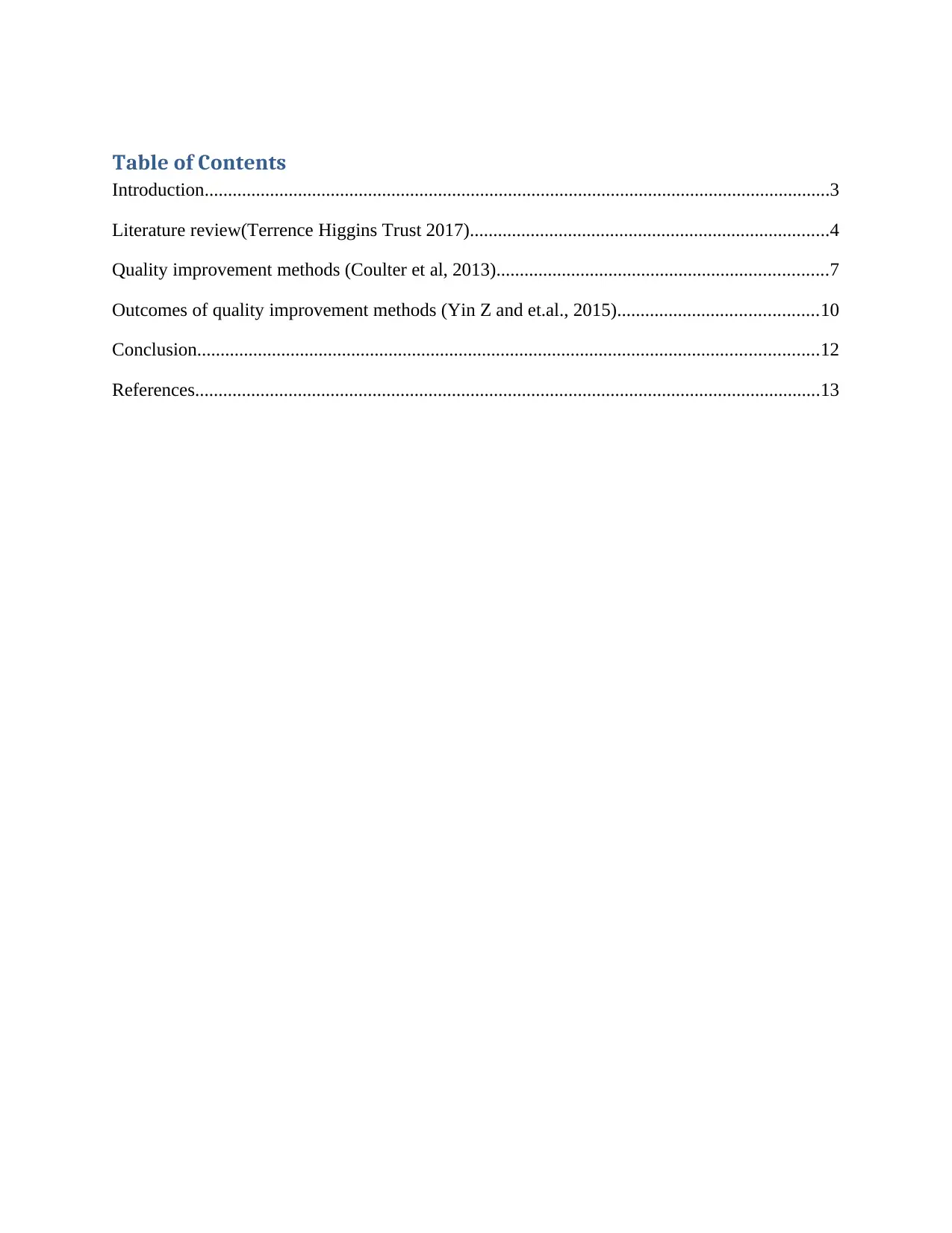
Table of Contents
Introduction......................................................................................................................................3
Literature review(Terrence Higgins Trust 2017).............................................................................4
Quality improvement methods (Coulter et al, 2013).......................................................................7
Outcomes of quality improvement methods (Yin Z and et.al., 2015)...........................................10
Conclusion.....................................................................................................................................12
References......................................................................................................................................13
Introduction......................................................................................................................................3
Literature review(Terrence Higgins Trust 2017).............................................................................4
Quality improvement methods (Coulter et al, 2013).......................................................................7
Outcomes of quality improvement methods (Yin Z and et.al., 2015)...........................................10
Conclusion.....................................................................................................................................12
References......................................................................................................................................13
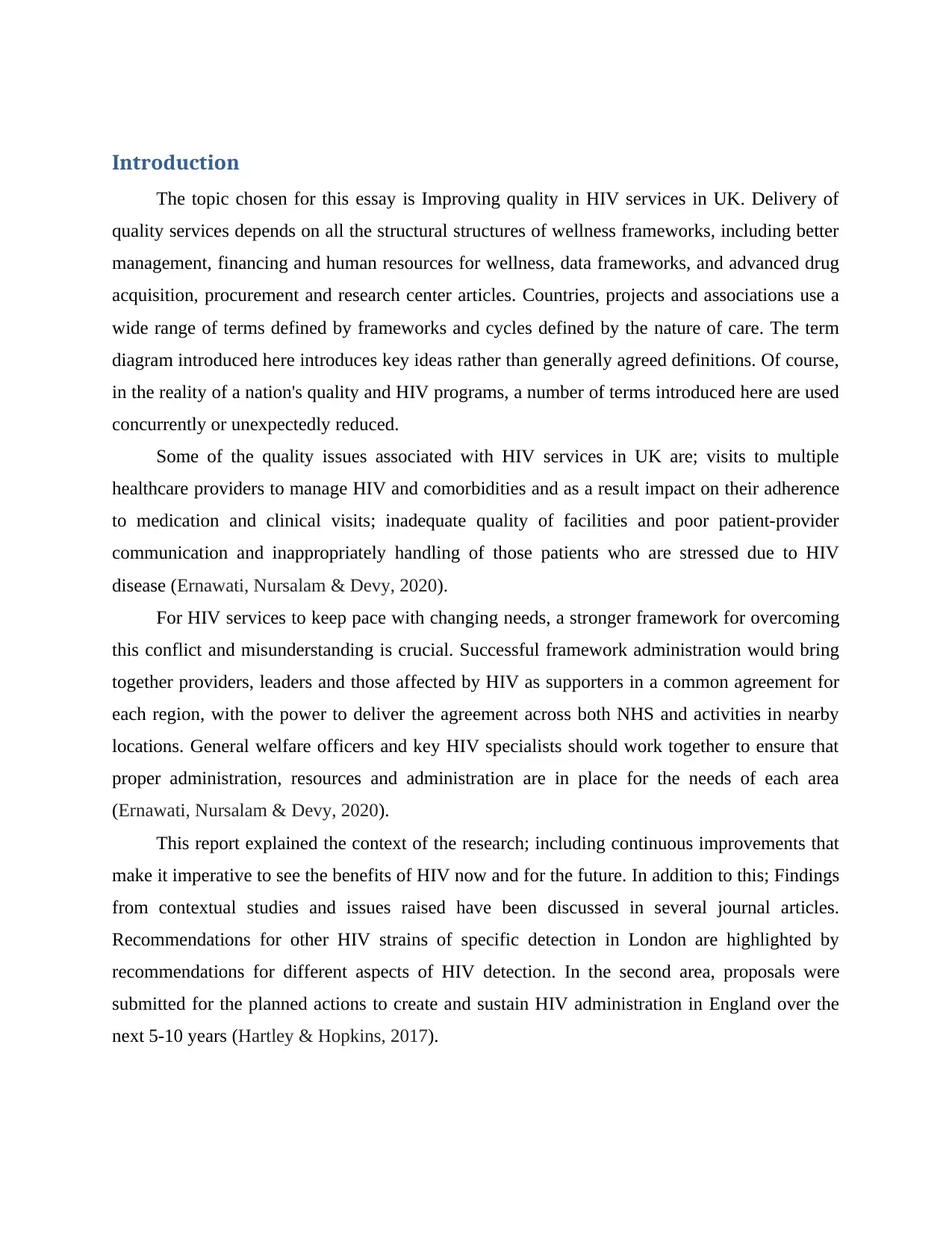
Introduction
The topic chosen for this essay is Improving quality in HIV services in UK. Delivery of
quality services depends on all the structural structures of wellness frameworks, including better
management, financing and human resources for wellness, data frameworks, and advanced drug
acquisition, procurement and research center articles. Countries, projects and associations use a
wide range of terms defined by frameworks and cycles defined by the nature of care. The term
diagram introduced here introduces key ideas rather than generally agreed definitions. Of course,
in the reality of a nation's quality and HIV programs, a number of terms introduced here are used
concurrently or unexpectedly reduced.
Some of the quality issues associated with HIV services in UK are; visits to multiple
healthcare providers to manage HIV and comorbidities and as a result impact on their adherence
to medication and clinical visits; inadequate quality of facilities and poor patient-provider
communication and inappropriately handling of those patients who are stressed due to HIV
disease (Ernawati, Nursalam & Devy, 2020).
For HIV services to keep pace with changing needs, a stronger framework for overcoming
this conflict and misunderstanding is crucial. Successful framework administration would bring
together providers, leaders and those affected by HIV as supporters in a common agreement for
each region, with the power to deliver the agreement across both NHS and activities in nearby
locations. General welfare officers and key HIV specialists should work together to ensure that
proper administration, resources and administration are in place for the needs of each area
(Ernawati, Nursalam & Devy, 2020).
This report explained the context of the research; including continuous improvements that
make it imperative to see the benefits of HIV now and for the future. In addition to this; Findings
from contextual studies and issues raised have been discussed in several journal articles.
Recommendations for other HIV strains of specific detection in London are highlighted by
recommendations for different aspects of HIV detection. In the second area, proposals were
submitted for the planned actions to create and sustain HIV administration in England over the
next 5-10 years (Hartley & Hopkins, 2017).
The topic chosen for this essay is Improving quality in HIV services in UK. Delivery of
quality services depends on all the structural structures of wellness frameworks, including better
management, financing and human resources for wellness, data frameworks, and advanced drug
acquisition, procurement and research center articles. Countries, projects and associations use a
wide range of terms defined by frameworks and cycles defined by the nature of care. The term
diagram introduced here introduces key ideas rather than generally agreed definitions. Of course,
in the reality of a nation's quality and HIV programs, a number of terms introduced here are used
concurrently or unexpectedly reduced.
Some of the quality issues associated with HIV services in UK are; visits to multiple
healthcare providers to manage HIV and comorbidities and as a result impact on their adherence
to medication and clinical visits; inadequate quality of facilities and poor patient-provider
communication and inappropriately handling of those patients who are stressed due to HIV
disease (Ernawati, Nursalam & Devy, 2020).
For HIV services to keep pace with changing needs, a stronger framework for overcoming
this conflict and misunderstanding is crucial. Successful framework administration would bring
together providers, leaders and those affected by HIV as supporters in a common agreement for
each region, with the power to deliver the agreement across both NHS and activities in nearby
locations. General welfare officers and key HIV specialists should work together to ensure that
proper administration, resources and administration are in place for the needs of each area
(Ernawati, Nursalam & Devy, 2020).
This report explained the context of the research; including continuous improvements that
make it imperative to see the benefits of HIV now and for the future. In addition to this; Findings
from contextual studies and issues raised have been discussed in several journal articles.
Recommendations for other HIV strains of specific detection in London are highlighted by
recommendations for different aspects of HIV detection. In the second area, proposals were
submitted for the planned actions to create and sustain HIV administration in England over the
next 5-10 years (Hartley & Hopkins, 2017).
⊘ This is a preview!⊘
Do you want full access?
Subscribe today to unlock all pages.

Trusted by 1+ million students worldwide
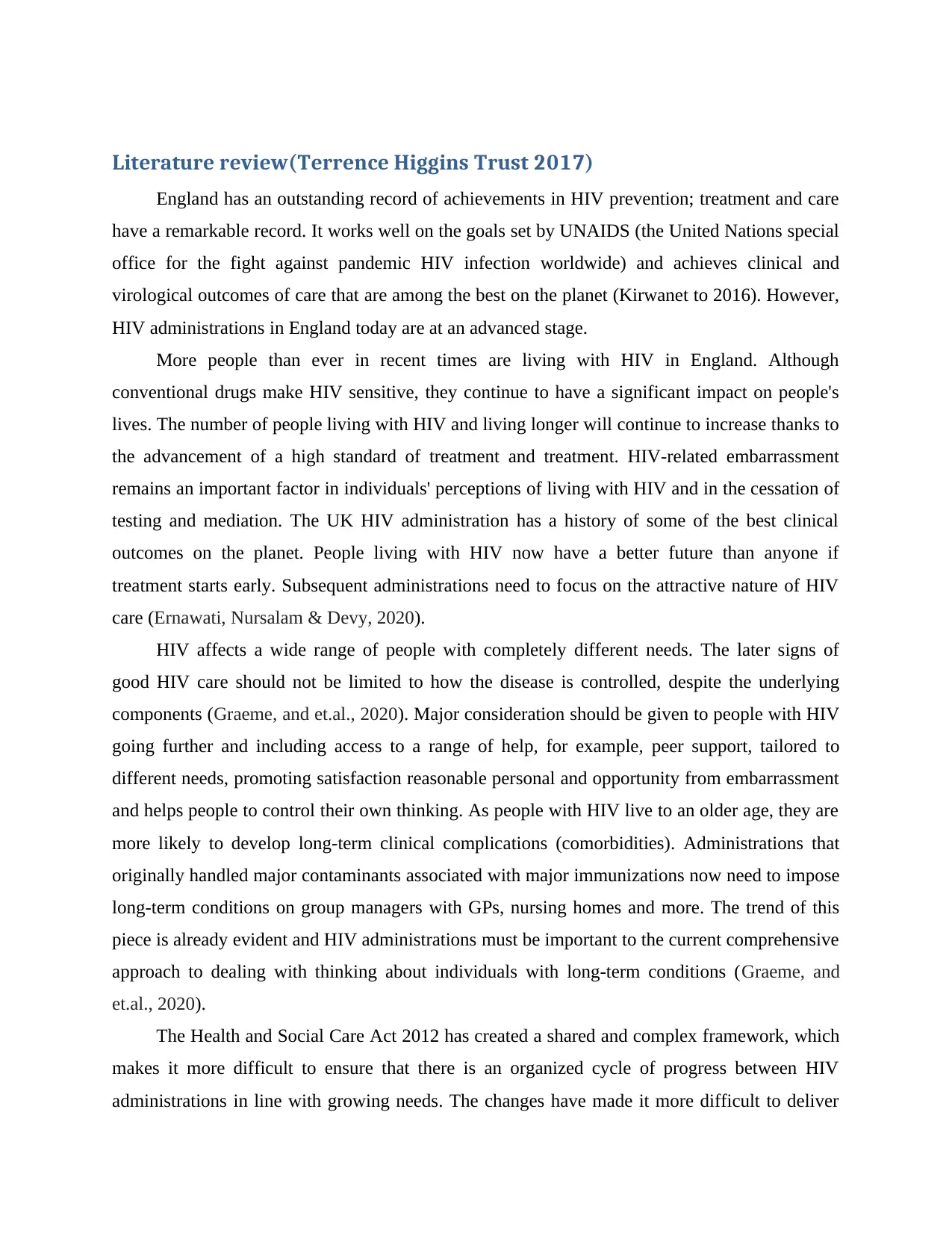
Literature review(Terrence Higgins Trust 2017)
England has an outstanding record of achievements in HIV prevention; treatment and care
have a remarkable record. It works well on the goals set by UNAIDS (the United Nations special
office for the fight against pandemic HIV infection worldwide) and achieves clinical and
virological outcomes of care that are among the best on the planet (Kirwanet to 2016). However,
HIV administrations in England today are at an advanced stage.
More people than ever in recent times are living with HIV in England. Although
conventional drugs make HIV sensitive, they continue to have a significant impact on people's
lives. The number of people living with HIV and living longer will continue to increase thanks to
the advancement of a high standard of treatment and treatment. HIV-related embarrassment
remains an important factor in individuals' perceptions of living with HIV and in the cessation of
testing and mediation. The UK HIV administration has a history of some of the best clinical
outcomes on the planet. People living with HIV now have a better future than anyone if
treatment starts early. Subsequent administrations need to focus on the attractive nature of HIV
care (Ernawati, Nursalam & Devy, 2020).
HIV affects a wide range of people with completely different needs. The later signs of
good HIV care should not be limited to how the disease is controlled, despite the underlying
components (Graeme, and et.al., 2020). Major consideration should be given to people with HIV
going further and including access to a range of help, for example, peer support, tailored to
different needs, promoting satisfaction reasonable personal and opportunity from embarrassment
and helps people to control their own thinking. As people with HIV live to an older age, they are
more likely to develop long-term clinical complications (comorbidities). Administrations that
originally handled major contaminants associated with major immunizations now need to impose
long-term conditions on group managers with GPs, nursing homes and more. The trend of this
piece is already evident and HIV administrations must be important to the current comprehensive
approach to dealing with thinking about individuals with long-term conditions (Graeme, and
et.al., 2020).
The Health and Social Care Act 2012 has created a shared and complex framework, which
makes it more difficult to ensure that there is an organized cycle of progress between HIV
administrations in line with growing needs. The changes have made it more difficult to deliver
England has an outstanding record of achievements in HIV prevention; treatment and care
have a remarkable record. It works well on the goals set by UNAIDS (the United Nations special
office for the fight against pandemic HIV infection worldwide) and achieves clinical and
virological outcomes of care that are among the best on the planet (Kirwanet to 2016). However,
HIV administrations in England today are at an advanced stage.
More people than ever in recent times are living with HIV in England. Although
conventional drugs make HIV sensitive, they continue to have a significant impact on people's
lives. The number of people living with HIV and living longer will continue to increase thanks to
the advancement of a high standard of treatment and treatment. HIV-related embarrassment
remains an important factor in individuals' perceptions of living with HIV and in the cessation of
testing and mediation. The UK HIV administration has a history of some of the best clinical
outcomes on the planet. People living with HIV now have a better future than anyone if
treatment starts early. Subsequent administrations need to focus on the attractive nature of HIV
care (Ernawati, Nursalam & Devy, 2020).
HIV affects a wide range of people with completely different needs. The later signs of
good HIV care should not be limited to how the disease is controlled, despite the underlying
components (Graeme, and et.al., 2020). Major consideration should be given to people with HIV
going further and including access to a range of help, for example, peer support, tailored to
different needs, promoting satisfaction reasonable personal and opportunity from embarrassment
and helps people to control their own thinking. As people with HIV live to an older age, they are
more likely to develop long-term clinical complications (comorbidities). Administrations that
originally handled major contaminants associated with major immunizations now need to impose
long-term conditions on group managers with GPs, nursing homes and more. The trend of this
piece is already evident and HIV administrations must be important to the current comprehensive
approach to dealing with thinking about individuals with long-term conditions (Graeme, and
et.al., 2020).
The Health and Social Care Act 2012 has created a shared and complex framework, which
makes it more difficult to ensure that there is an organized cycle of progress between HIV
administrations in line with growing needs. The changes have made it more difficult to deliver
Paraphrase This Document
Need a fresh take? Get an instant paraphrase of this document with our AI Paraphraser
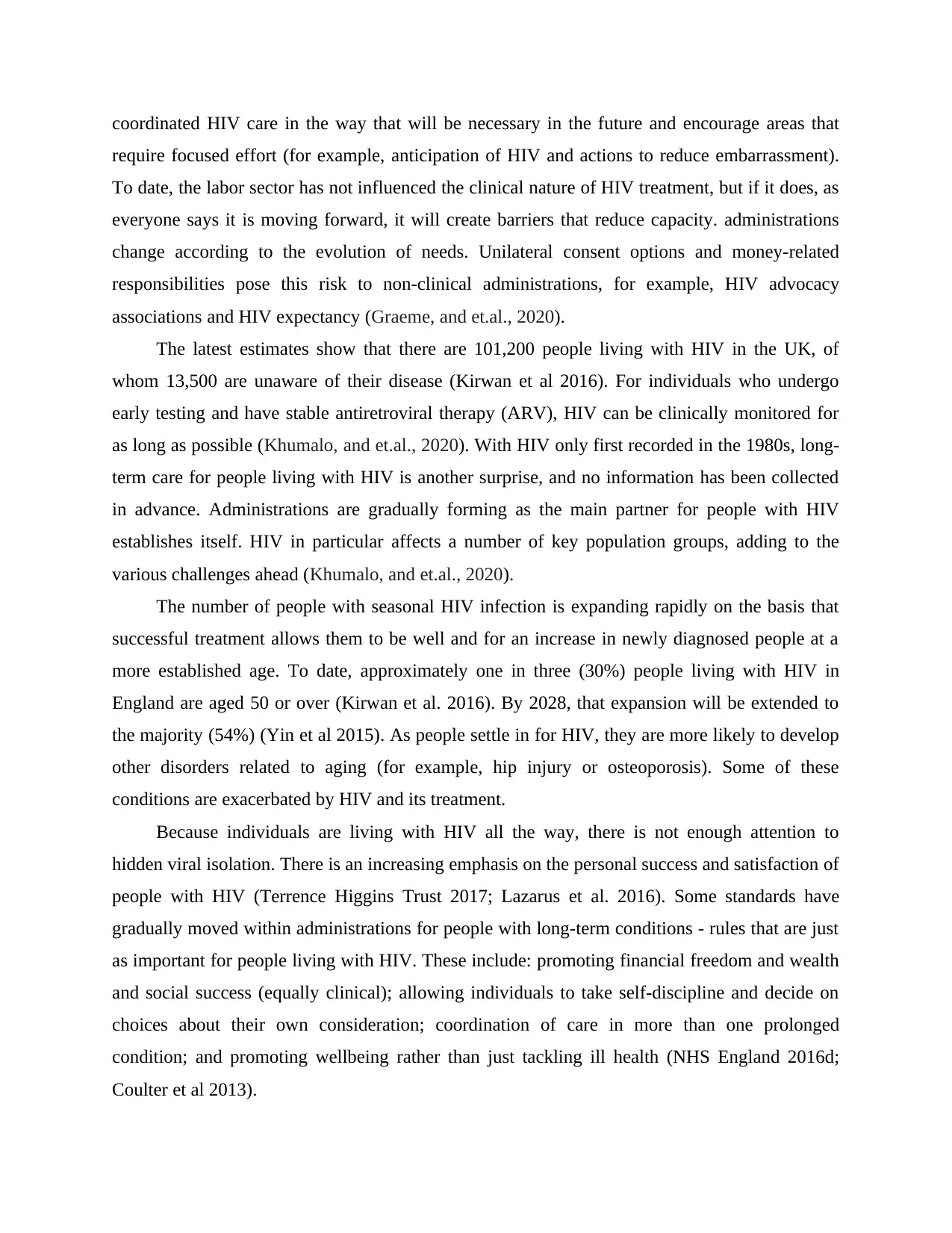
coordinated HIV care in the way that will be necessary in the future and encourage areas that
require focused effort (for example, anticipation of HIV and actions to reduce embarrassment).
To date, the labor sector has not influenced the clinical nature of HIV treatment, but if it does, as
everyone says it is moving forward, it will create barriers that reduce capacity. administrations
change according to the evolution of needs. Unilateral consent options and money-related
responsibilities pose this risk to non-clinical administrations, for example, HIV advocacy
associations and HIV expectancy (Graeme, and et.al., 2020).
The latest estimates show that there are 101,200 people living with HIV in the UK, of
whom 13,500 are unaware of their disease (Kirwan et al 2016). For individuals who undergo
early testing and have stable antiretroviral therapy (ARV), HIV can be clinically monitored for
as long as possible (Khumalo, and et.al., 2020). With HIV only first recorded in the 1980s, long-
term care for people living with HIV is another surprise, and no information has been collected
in advance. Administrations are gradually forming as the main partner for people with HIV
establishes itself. HIV in particular affects a number of key population groups, adding to the
various challenges ahead (Khumalo, and et.al., 2020).
The number of people with seasonal HIV infection is expanding rapidly on the basis that
successful treatment allows them to be well and for an increase in newly diagnosed people at a
more established age. To date, approximately one in three (30%) people living with HIV in
England are aged 50 or over (Kirwan et al. 2016). By 2028, that expansion will be extended to
the majority (54%) (Yin et al 2015). As people settle in for HIV, they are more likely to develop
other disorders related to aging (for example, hip injury or osteoporosis). Some of these
conditions are exacerbated by HIV and its treatment.
Because individuals are living with HIV all the way, there is not enough attention to
hidden viral isolation. There is an increasing emphasis on the personal success and satisfaction of
people with HIV (Terrence Higgins Trust 2017; Lazarus et al. 2016). Some standards have
gradually moved within administrations for people with long-term conditions - rules that are just
as important for people living with HIV. These include: promoting financial freedom and wealth
and social success (equally clinical); allowing individuals to take self-discipline and decide on
choices about their own consideration; coordination of care in more than one prolonged
condition; and promoting wellbeing rather than just tackling ill health (NHS England 2016d;
Coulter et al 2013).
require focused effort (for example, anticipation of HIV and actions to reduce embarrassment).
To date, the labor sector has not influenced the clinical nature of HIV treatment, but if it does, as
everyone says it is moving forward, it will create barriers that reduce capacity. administrations
change according to the evolution of needs. Unilateral consent options and money-related
responsibilities pose this risk to non-clinical administrations, for example, HIV advocacy
associations and HIV expectancy (Graeme, and et.al., 2020).
The latest estimates show that there are 101,200 people living with HIV in the UK, of
whom 13,500 are unaware of their disease (Kirwan et al 2016). For individuals who undergo
early testing and have stable antiretroviral therapy (ARV), HIV can be clinically monitored for
as long as possible (Khumalo, and et.al., 2020). With HIV only first recorded in the 1980s, long-
term care for people living with HIV is another surprise, and no information has been collected
in advance. Administrations are gradually forming as the main partner for people with HIV
establishes itself. HIV in particular affects a number of key population groups, adding to the
various challenges ahead (Khumalo, and et.al., 2020).
The number of people with seasonal HIV infection is expanding rapidly on the basis that
successful treatment allows them to be well and for an increase in newly diagnosed people at a
more established age. To date, approximately one in three (30%) people living with HIV in
England are aged 50 or over (Kirwan et al. 2016). By 2028, that expansion will be extended to
the majority (54%) (Yin et al 2015). As people settle in for HIV, they are more likely to develop
other disorders related to aging (for example, hip injury or osteoporosis). Some of these
conditions are exacerbated by HIV and its treatment.
Because individuals are living with HIV all the way, there is not enough attention to
hidden viral isolation. There is an increasing emphasis on the personal success and satisfaction of
people with HIV (Terrence Higgins Trust 2017; Lazarus et al. 2016). Some standards have
gradually moved within administrations for people with long-term conditions - rules that are just
as important for people living with HIV. These include: promoting financial freedom and wealth
and social success (equally clinical); allowing individuals to take self-discipline and decide on
choices about their own consideration; coordination of care in more than one prolonged
condition; and promoting wellbeing rather than just tackling ill health (NHS England 2016d;
Coulter et al 2013).
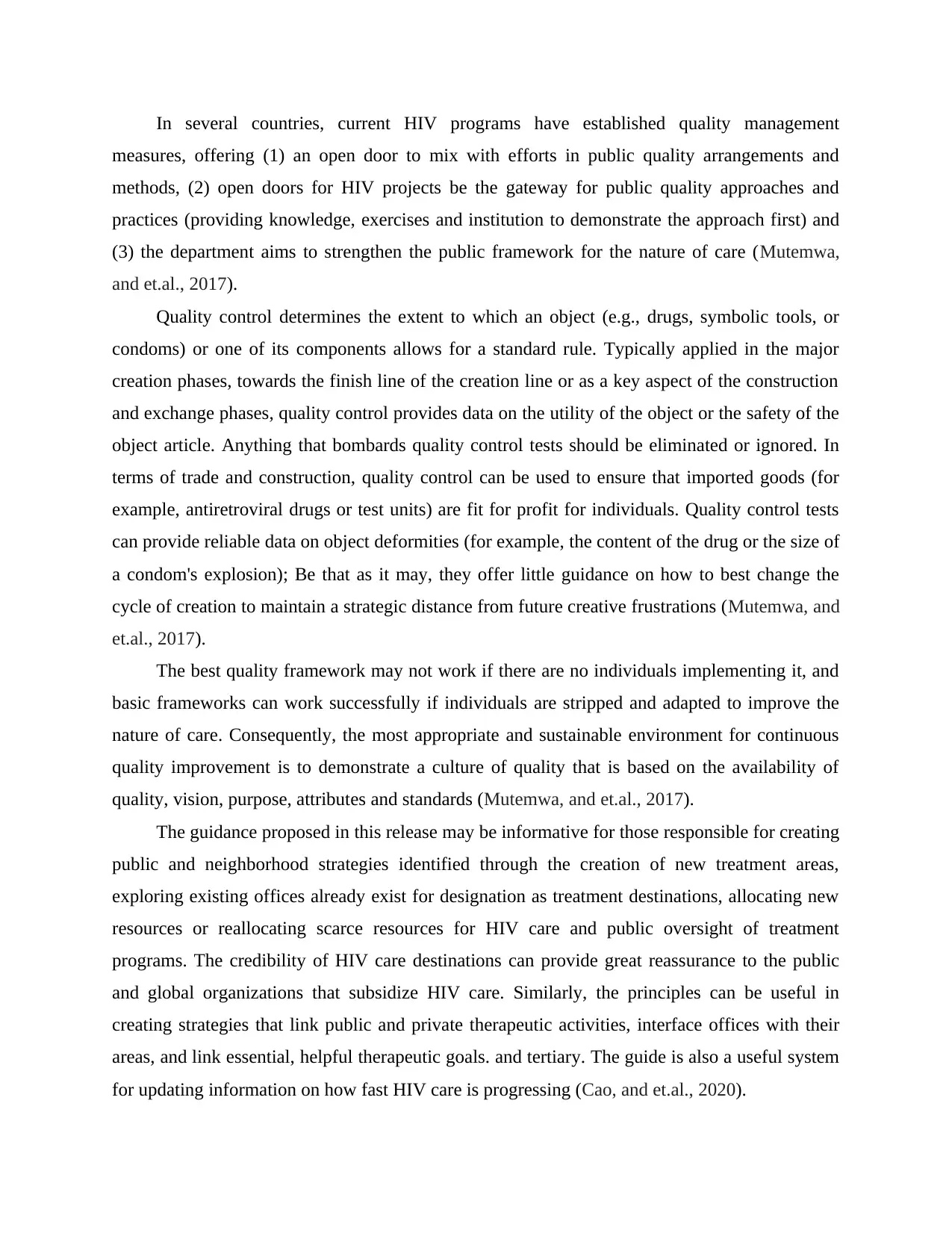
In several countries, current HIV programs have established quality management
measures, offering (1) an open door to mix with efforts in public quality arrangements and
methods, (2) open doors for HIV projects be the gateway for public quality approaches and
practices (providing knowledge, exercises and institution to demonstrate the approach first) and
(3) the department aims to strengthen the public framework for the nature of care (Mutemwa,
and et.al., 2017).
Quality control determines the extent to which an object (e.g., drugs, symbolic tools, or
condoms) or one of its components allows for a standard rule. Typically applied in the major
creation phases, towards the finish line of the creation line or as a key aspect of the construction
and exchange phases, quality control provides data on the utility of the object or the safety of the
object article. Anything that bombards quality control tests should be eliminated or ignored. In
terms of trade and construction, quality control can be used to ensure that imported goods (for
example, antiretroviral drugs or test units) are fit for profit for individuals. Quality control tests
can provide reliable data on object deformities (for example, the content of the drug or the size of
a condom's explosion); Be that as it may, they offer little guidance on how to best change the
cycle of creation to maintain a strategic distance from future creative frustrations (Mutemwa, and
et.al., 2017).
The best quality framework may not work if there are no individuals implementing it, and
basic frameworks can work successfully if individuals are stripped and adapted to improve the
nature of care. Consequently, the most appropriate and sustainable environment for continuous
quality improvement is to demonstrate a culture of quality that is based on the availability of
quality, vision, purpose, attributes and standards (Mutemwa, and et.al., 2017).
The guidance proposed in this release may be informative for those responsible for creating
public and neighborhood strategies identified through the creation of new treatment areas,
exploring existing offices already exist for designation as treatment destinations, allocating new
resources or reallocating scarce resources for HIV care and public oversight of treatment
programs. The credibility of HIV care destinations can provide great reassurance to the public
and global organizations that subsidize HIV care. Similarly, the principles can be useful in
creating strategies that link public and private therapeutic activities, interface offices with their
areas, and link essential, helpful therapeutic goals. and tertiary. The guide is also a useful system
for updating information on how fast HIV care is progressing (Cao, and et.al., 2020).
measures, offering (1) an open door to mix with efforts in public quality arrangements and
methods, (2) open doors for HIV projects be the gateway for public quality approaches and
practices (providing knowledge, exercises and institution to demonstrate the approach first) and
(3) the department aims to strengthen the public framework for the nature of care (Mutemwa,
and et.al., 2017).
Quality control determines the extent to which an object (e.g., drugs, symbolic tools, or
condoms) or one of its components allows for a standard rule. Typically applied in the major
creation phases, towards the finish line of the creation line or as a key aspect of the construction
and exchange phases, quality control provides data on the utility of the object or the safety of the
object article. Anything that bombards quality control tests should be eliminated or ignored. In
terms of trade and construction, quality control can be used to ensure that imported goods (for
example, antiretroviral drugs or test units) are fit for profit for individuals. Quality control tests
can provide reliable data on object deformities (for example, the content of the drug or the size of
a condom's explosion); Be that as it may, they offer little guidance on how to best change the
cycle of creation to maintain a strategic distance from future creative frustrations (Mutemwa, and
et.al., 2017).
The best quality framework may not work if there are no individuals implementing it, and
basic frameworks can work successfully if individuals are stripped and adapted to improve the
nature of care. Consequently, the most appropriate and sustainable environment for continuous
quality improvement is to demonstrate a culture of quality that is based on the availability of
quality, vision, purpose, attributes and standards (Mutemwa, and et.al., 2017).
The guidance proposed in this release may be informative for those responsible for creating
public and neighborhood strategies identified through the creation of new treatment areas,
exploring existing offices already exist for designation as treatment destinations, allocating new
resources or reallocating scarce resources for HIV care and public oversight of treatment
programs. The credibility of HIV care destinations can provide great reassurance to the public
and global organizations that subsidize HIV care. Similarly, the principles can be useful in
creating strategies that link public and private therapeutic activities, interface offices with their
areas, and link essential, helpful therapeutic goals. and tertiary. The guide is also a useful system
for updating information on how fast HIV care is progressing (Cao, and et.al., 2020).
⊘ This is a preview!⊘
Do you want full access?
Subscribe today to unlock all pages.

Trusted by 1+ million students worldwide
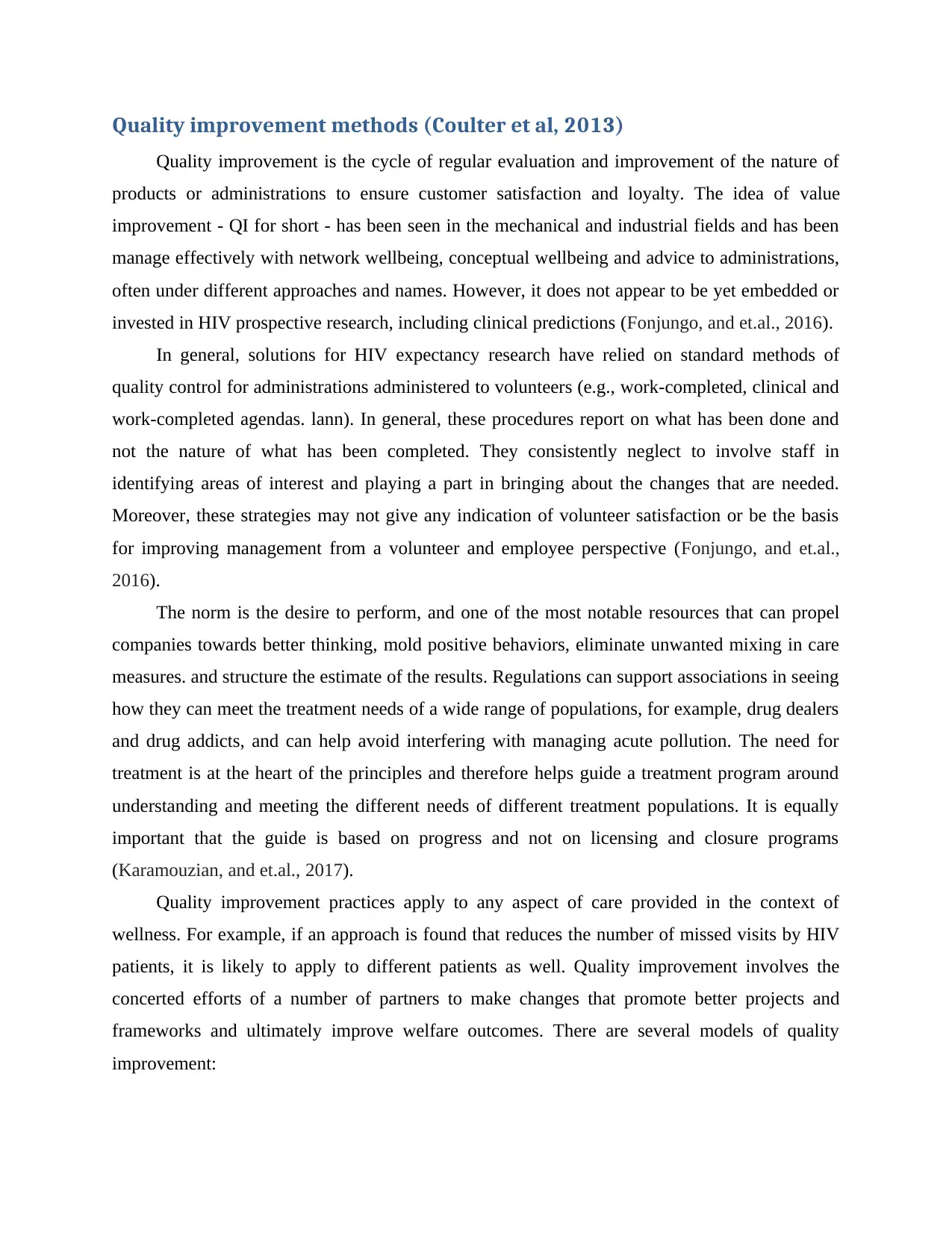
Quality improvement methods (Coulter et al, 2013)
Quality improvement is the cycle of regular evaluation and improvement of the nature of
products or administrations to ensure customer satisfaction and loyalty. The idea of value
improvement - QI for short - has been seen in the mechanical and industrial fields and has been
manage effectively with network wellbeing, conceptual wellbeing and advice to administrations,
often under different approaches and names. However, it does not appear to be yet embedded or
invested in HIV prospective research, including clinical predictions (Fonjungo, and et.al., 2016).
In general, solutions for HIV expectancy research have relied on standard methods of
quality control for administrations administered to volunteers (e.g., work-completed, clinical and
work-completed agendas. lann). In general, these procedures report on what has been done and
not the nature of what has been completed. They consistently neglect to involve staff in
identifying areas of interest and playing a part in bringing about the changes that are needed.
Moreover, these strategies may not give any indication of volunteer satisfaction or be the basis
for improving management from a volunteer and employee perspective (Fonjungo, and et.al.,
2016).
The norm is the desire to perform, and one of the most notable resources that can propel
companies towards better thinking, mold positive behaviors, eliminate unwanted mixing in care
measures. and structure the estimate of the results. Regulations can support associations in seeing
how they can meet the treatment needs of a wide range of populations, for example, drug dealers
and drug addicts, and can help avoid interfering with managing acute pollution. The need for
treatment is at the heart of the principles and therefore helps guide a treatment program around
understanding and meeting the different needs of different treatment populations. It is equally
important that the guide is based on progress and not on licensing and closure programs
(Karamouzian, and et.al., 2017).
Quality improvement practices apply to any aspect of care provided in the context of
wellness. For example, if an approach is found that reduces the number of missed visits by HIV
patients, it is likely to apply to different patients as well. Quality improvement involves the
concerted efforts of a number of partners to make changes that promote better projects and
frameworks and ultimately improve welfare outcomes. There are several models of quality
improvement:
Quality improvement is the cycle of regular evaluation and improvement of the nature of
products or administrations to ensure customer satisfaction and loyalty. The idea of value
improvement - QI for short - has been seen in the mechanical and industrial fields and has been
manage effectively with network wellbeing, conceptual wellbeing and advice to administrations,
often under different approaches and names. However, it does not appear to be yet embedded or
invested in HIV prospective research, including clinical predictions (Fonjungo, and et.al., 2016).
In general, solutions for HIV expectancy research have relied on standard methods of
quality control for administrations administered to volunteers (e.g., work-completed, clinical and
work-completed agendas. lann). In general, these procedures report on what has been done and
not the nature of what has been completed. They consistently neglect to involve staff in
identifying areas of interest and playing a part in bringing about the changes that are needed.
Moreover, these strategies may not give any indication of volunteer satisfaction or be the basis
for improving management from a volunteer and employee perspective (Fonjungo, and et.al.,
2016).
The norm is the desire to perform, and one of the most notable resources that can propel
companies towards better thinking, mold positive behaviors, eliminate unwanted mixing in care
measures. and structure the estimate of the results. Regulations can support associations in seeing
how they can meet the treatment needs of a wide range of populations, for example, drug dealers
and drug addicts, and can help avoid interfering with managing acute pollution. The need for
treatment is at the heart of the principles and therefore helps guide a treatment program around
understanding and meeting the different needs of different treatment populations. It is equally
important that the guide is based on progress and not on licensing and closure programs
(Karamouzian, and et.al., 2017).
Quality improvement practices apply to any aspect of care provided in the context of
wellness. For example, if an approach is found that reduces the number of missed visits by HIV
patients, it is likely to apply to different patients as well. Quality improvement involves the
concerted efforts of a number of partners to make changes that promote better projects and
frameworks and ultimately improve welfare outcomes. There are several models of quality
improvement:
Paraphrase This Document
Need a fresh take? Get an instant paraphrase of this document with our AI Paraphraser
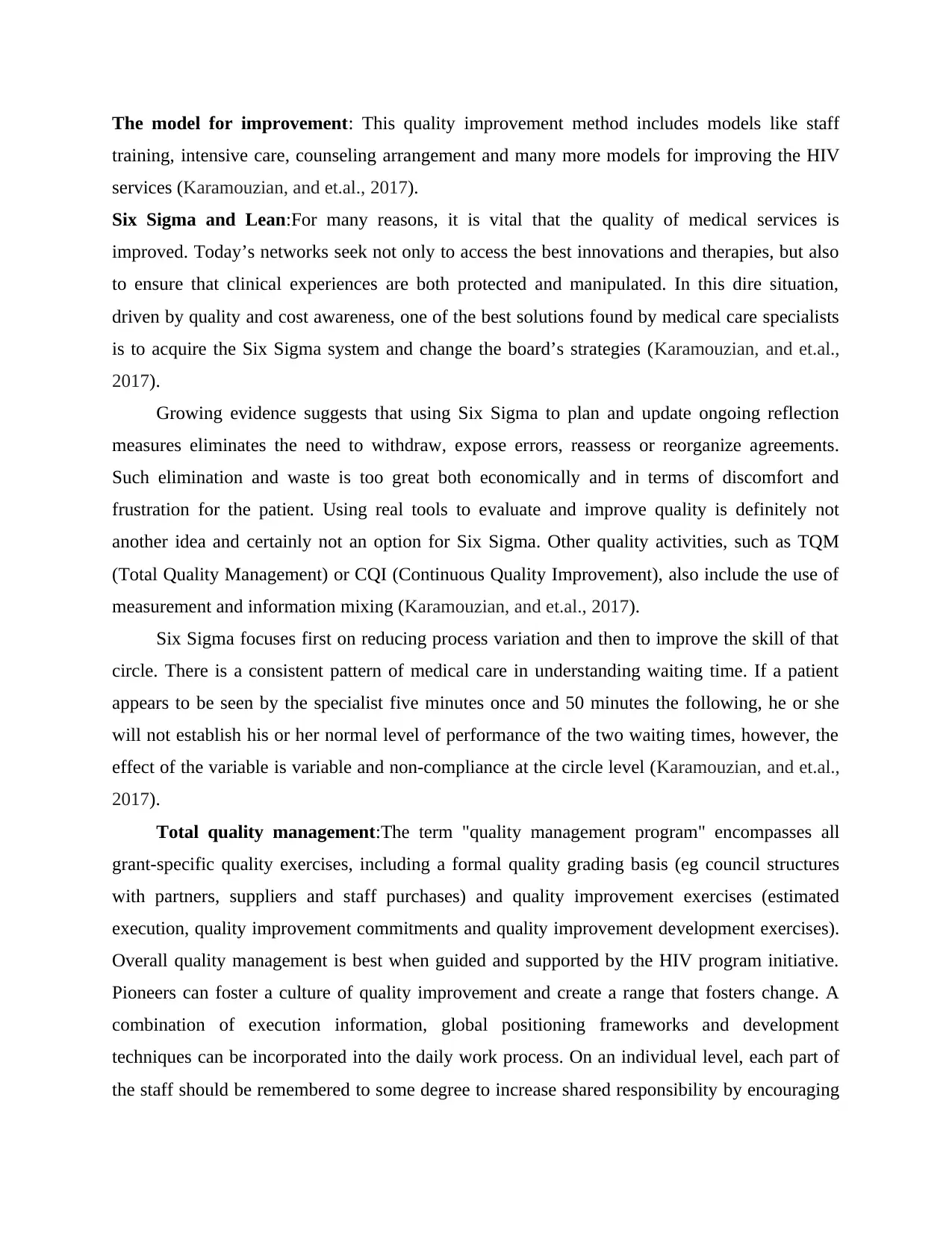
The model for improvement: This quality improvement method includes models like staff
training, intensive care, counseling arrangement and many more models for improving the HIV
services (Karamouzian, and et.al., 2017).
Six Sigma and Lean:For many reasons, it is vital that the quality of medical services is
improved. Today’s networks seek not only to access the best innovations and therapies, but also
to ensure that clinical experiences are both protected and manipulated. In this dire situation,
driven by quality and cost awareness, one of the best solutions found by medical care specialists
is to acquire the Six Sigma system and change the board’s strategies (Karamouzian, and et.al.,
2017).
Growing evidence suggests that using Six Sigma to plan and update ongoing reflection
measures eliminates the need to withdraw, expose errors, reassess or reorganize agreements.
Such elimination and waste is too great both economically and in terms of discomfort and
frustration for the patient. Using real tools to evaluate and improve quality is definitely not
another idea and certainly not an option for Six Sigma. Other quality activities, such as TQM
(Total Quality Management) or CQI (Continuous Quality Improvement), also include the use of
measurement and information mixing (Karamouzian, and et.al., 2017).
Six Sigma focuses first on reducing process variation and then to improve the skill of that
circle. There is a consistent pattern of medical care in understanding waiting time. If a patient
appears to be seen by the specialist five minutes once and 50 minutes the following, he or she
will not establish his or her normal level of performance of the two waiting times, however, the
effect of the variable is variable and non-compliance at the circle level (Karamouzian, and et.al.,
2017).
Total quality management:The term "quality management program" encompasses all
grant-specific quality exercises, including a formal quality grading basis (eg council structures
with partners, suppliers and staff purchases) and quality improvement exercises (estimated
execution, quality improvement commitments and quality improvement development exercises).
Overall quality management is best when guided and supported by the HIV program initiative.
Pioneers can foster a culture of quality improvement and create a range that fosters change. A
combination of execution information, global positioning frameworks and development
techniques can be incorporated into the daily work process. On an individual level, each part of
the staff should be remembered to some degree to increase shared responsibility by encouraging
training, intensive care, counseling arrangement and many more models for improving the HIV
services (Karamouzian, and et.al., 2017).
Six Sigma and Lean:For many reasons, it is vital that the quality of medical services is
improved. Today’s networks seek not only to access the best innovations and therapies, but also
to ensure that clinical experiences are both protected and manipulated. In this dire situation,
driven by quality and cost awareness, one of the best solutions found by medical care specialists
is to acquire the Six Sigma system and change the board’s strategies (Karamouzian, and et.al.,
2017).
Growing evidence suggests that using Six Sigma to plan and update ongoing reflection
measures eliminates the need to withdraw, expose errors, reassess or reorganize agreements.
Such elimination and waste is too great both economically and in terms of discomfort and
frustration for the patient. Using real tools to evaluate and improve quality is definitely not
another idea and certainly not an option for Six Sigma. Other quality activities, such as TQM
(Total Quality Management) or CQI (Continuous Quality Improvement), also include the use of
measurement and information mixing (Karamouzian, and et.al., 2017).
Six Sigma focuses first on reducing process variation and then to improve the skill of that
circle. There is a consistent pattern of medical care in understanding waiting time. If a patient
appears to be seen by the specialist five minutes once and 50 minutes the following, he or she
will not establish his or her normal level of performance of the two waiting times, however, the
effect of the variable is variable and non-compliance at the circle level (Karamouzian, and et.al.,
2017).
Total quality management:The term "quality management program" encompasses all
grant-specific quality exercises, including a formal quality grading basis (eg council structures
with partners, suppliers and staff purchases) and quality improvement exercises (estimated
execution, quality improvement commitments and quality improvement development exercises).
Overall quality management is best when guided and supported by the HIV program initiative.
Pioneers can foster a culture of quality improvement and create a range that fosters change. A
combination of execution information, global positioning frameworks and development
techniques can be incorporated into the daily work process. On an individual level, each part of
the staff should be remembered to some degree to increase shared responsibility by encouraging
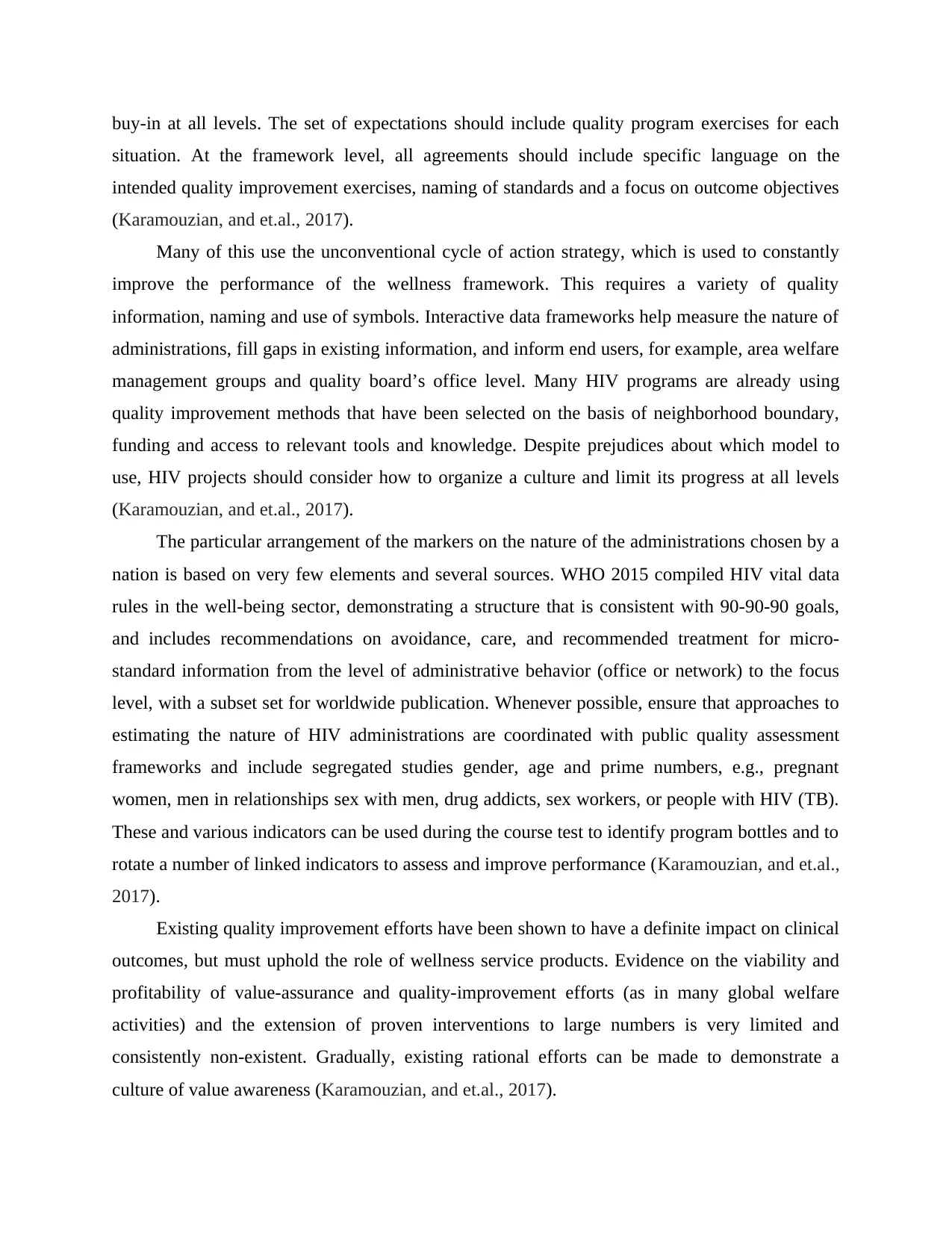
buy-in at all levels. The set of expectations should include quality program exercises for each
situation. At the framework level, all agreements should include specific language on the
intended quality improvement exercises, naming of standards and a focus on outcome objectives
(Karamouzian, and et.al., 2017).
Many of this use the unconventional cycle of action strategy, which is used to constantly
improve the performance of the wellness framework. This requires a variety of quality
information, naming and use of symbols. Interactive data frameworks help measure the nature of
administrations, fill gaps in existing information, and inform end users, for example, area welfare
management groups and quality board’s office level. Many HIV programs are already using
quality improvement methods that have been selected on the basis of neighborhood boundary,
funding and access to relevant tools and knowledge. Despite prejudices about which model to
use, HIV projects should consider how to organize a culture and limit its progress at all levels
(Karamouzian, and et.al., 2017).
The particular arrangement of the markers on the nature of the administrations chosen by a
nation is based on very few elements and several sources. WHO 2015 compiled HIV vital data
rules in the well-being sector, demonstrating a structure that is consistent with 90-90-90 goals,
and includes recommendations on avoidance, care, and recommended treatment for micro-
standard information from the level of administrative behavior (office or network) to the focus
level, with a subset set for worldwide publication. Whenever possible, ensure that approaches to
estimating the nature of HIV administrations are coordinated with public quality assessment
frameworks and include segregated studies gender, age and prime numbers, e.g., pregnant
women, men in relationships sex with men, drug addicts, sex workers, or people with HIV (TB).
These and various indicators can be used during the course test to identify program bottles and to
rotate a number of linked indicators to assess and improve performance (Karamouzian, and et.al.,
2017).
Existing quality improvement efforts have been shown to have a definite impact on clinical
outcomes, but must uphold the role of wellness service products. Evidence on the viability and
profitability of value-assurance and quality-improvement efforts (as in many global welfare
activities) and the extension of proven interventions to large numbers is very limited and
consistently non-existent. Gradually, existing rational efforts can be made to demonstrate a
culture of value awareness (Karamouzian, and et.al., 2017).
situation. At the framework level, all agreements should include specific language on the
intended quality improvement exercises, naming of standards and a focus on outcome objectives
(Karamouzian, and et.al., 2017).
Many of this use the unconventional cycle of action strategy, which is used to constantly
improve the performance of the wellness framework. This requires a variety of quality
information, naming and use of symbols. Interactive data frameworks help measure the nature of
administrations, fill gaps in existing information, and inform end users, for example, area welfare
management groups and quality board’s office level. Many HIV programs are already using
quality improvement methods that have been selected on the basis of neighborhood boundary,
funding and access to relevant tools and knowledge. Despite prejudices about which model to
use, HIV projects should consider how to organize a culture and limit its progress at all levels
(Karamouzian, and et.al., 2017).
The particular arrangement of the markers on the nature of the administrations chosen by a
nation is based on very few elements and several sources. WHO 2015 compiled HIV vital data
rules in the well-being sector, demonstrating a structure that is consistent with 90-90-90 goals,
and includes recommendations on avoidance, care, and recommended treatment for micro-
standard information from the level of administrative behavior (office or network) to the focus
level, with a subset set for worldwide publication. Whenever possible, ensure that approaches to
estimating the nature of HIV administrations are coordinated with public quality assessment
frameworks and include segregated studies gender, age and prime numbers, e.g., pregnant
women, men in relationships sex with men, drug addicts, sex workers, or people with HIV (TB).
These and various indicators can be used during the course test to identify program bottles and to
rotate a number of linked indicators to assess and improve performance (Karamouzian, and et.al.,
2017).
Existing quality improvement efforts have been shown to have a definite impact on clinical
outcomes, but must uphold the role of wellness service products. Evidence on the viability and
profitability of value-assurance and quality-improvement efforts (as in many global welfare
activities) and the extension of proven interventions to large numbers is very limited and
consistently non-existent. Gradually, existing rational efforts can be made to demonstrate a
culture of value awareness (Karamouzian, and et.al., 2017).
⊘ This is a preview!⊘
Do you want full access?
Subscribe today to unlock all pages.

Trusted by 1+ million students worldwide
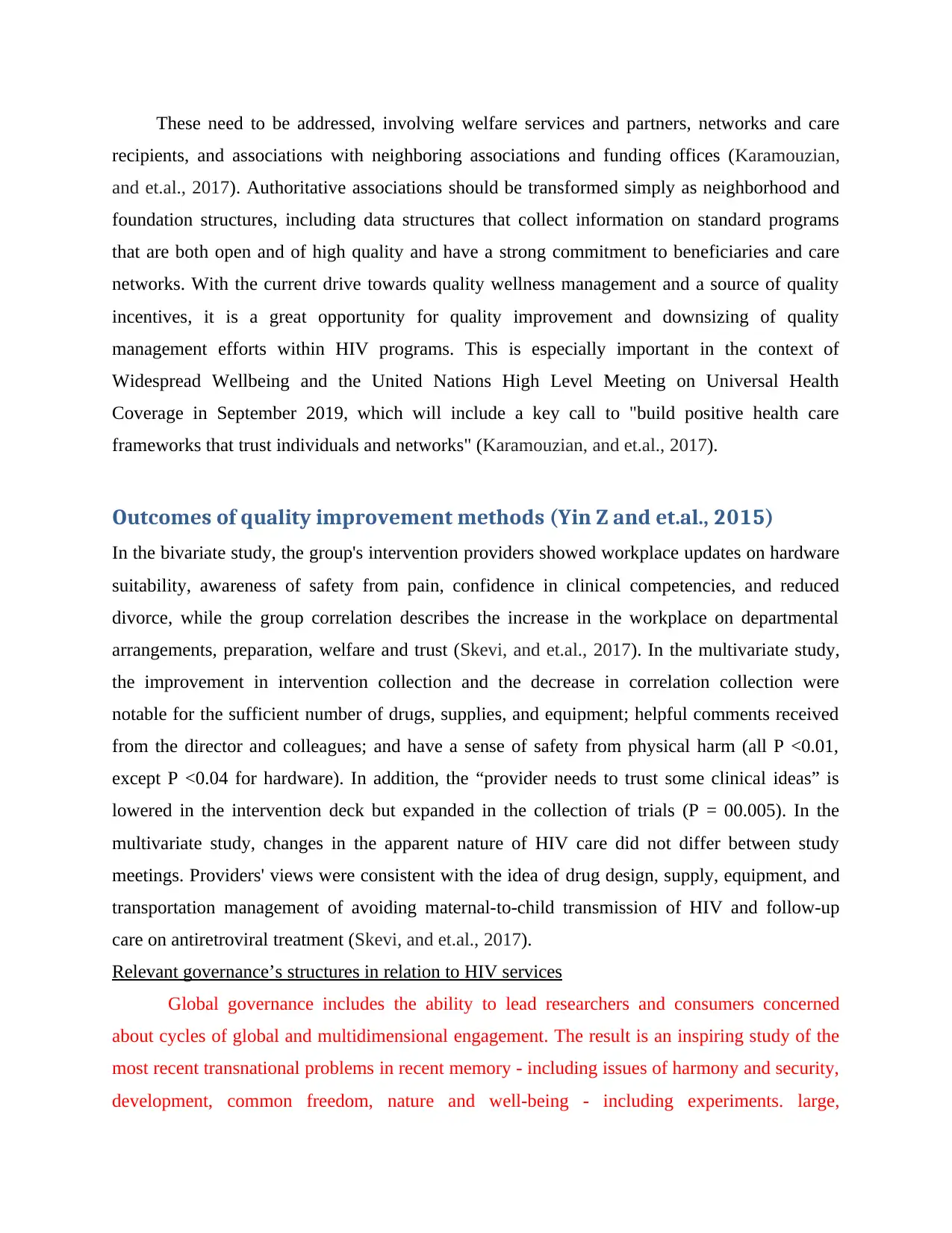
These need to be addressed, involving welfare services and partners, networks and care
recipients, and associations with neighboring associations and funding offices (Karamouzian,
and et.al., 2017). Authoritative associations should be transformed simply as neighborhood and
foundation structures, including data structures that collect information on standard programs
that are both open and of high quality and have a strong commitment to beneficiaries and care
networks. With the current drive towards quality wellness management and a source of quality
incentives, it is a great opportunity for quality improvement and downsizing of quality
management efforts within HIV programs. This is especially important in the context of
Widespread Wellbeing and the United Nations High Level Meeting on Universal Health
Coverage in September 2019, which will include a key call to "build positive health care
frameworks that trust individuals and networks" (Karamouzian, and et.al., 2017).
Outcomes of quality improvement methods (Yin Z and et.al., 2015)
In the bivariate study, the group's intervention providers showed workplace updates on hardware
suitability, awareness of safety from pain, confidence in clinical competencies, and reduced
divorce, while the group correlation describes the increase in the workplace on departmental
arrangements, preparation, welfare and trust (Skevi, and et.al., 2017). In the multivariate study,
the improvement in intervention collection and the decrease in correlation collection were
notable for the sufficient number of drugs, supplies, and equipment; helpful comments received
from the director and colleagues; and have a sense of safety from physical harm (all P <0.01,
except P <0.04 for hardware). In addition, the “provider needs to trust some clinical ideas” is
lowered in the intervention deck but expanded in the collection of trials (P = 00.005). In the
multivariate study, changes in the apparent nature of HIV care did not differ between study
meetings. Providers' views were consistent with the idea of drug design, supply, equipment, and
transportation management of avoiding maternal-to-child transmission of HIV and follow-up
care on antiretroviral treatment (Skevi, and et.al., 2017).
Relevant governance’s structures in relation to HIV services
Global governance includes the ability to lead researchers and consumers concerned
about cycles of global and multidimensional engagement. The result is an inspiring study of the
most recent transnational problems in recent memory - including issues of harmony and security,
development, common freedom, nature and well-being - including experiments. large,
recipients, and associations with neighboring associations and funding offices (Karamouzian,
and et.al., 2017). Authoritative associations should be transformed simply as neighborhood and
foundation structures, including data structures that collect information on standard programs
that are both open and of high quality and have a strong commitment to beneficiaries and care
networks. With the current drive towards quality wellness management and a source of quality
incentives, it is a great opportunity for quality improvement and downsizing of quality
management efforts within HIV programs. This is especially important in the context of
Widespread Wellbeing and the United Nations High Level Meeting on Universal Health
Coverage in September 2019, which will include a key call to "build positive health care
frameworks that trust individuals and networks" (Karamouzian, and et.al., 2017).
Outcomes of quality improvement methods (Yin Z and et.al., 2015)
In the bivariate study, the group's intervention providers showed workplace updates on hardware
suitability, awareness of safety from pain, confidence in clinical competencies, and reduced
divorce, while the group correlation describes the increase in the workplace on departmental
arrangements, preparation, welfare and trust (Skevi, and et.al., 2017). In the multivariate study,
the improvement in intervention collection and the decrease in correlation collection were
notable for the sufficient number of drugs, supplies, and equipment; helpful comments received
from the director and colleagues; and have a sense of safety from physical harm (all P <0.01,
except P <0.04 for hardware). In addition, the “provider needs to trust some clinical ideas” is
lowered in the intervention deck but expanded in the collection of trials (P = 00.005). In the
multivariate study, changes in the apparent nature of HIV care did not differ between study
meetings. Providers' views were consistent with the idea of drug design, supply, equipment, and
transportation management of avoiding maternal-to-child transmission of HIV and follow-up
care on antiretroviral treatment (Skevi, and et.al., 2017).
Relevant governance’s structures in relation to HIV services
Global governance includes the ability to lead researchers and consumers concerned
about cycles of global and multidimensional engagement. The result is an inspiring study of the
most recent transnational problems in recent memory - including issues of harmony and security,
development, common freedom, nature and well-being - including experiments. large,
Paraphrase This Document
Need a fresh take? Get an instant paraphrase of this document with our AI Paraphraser
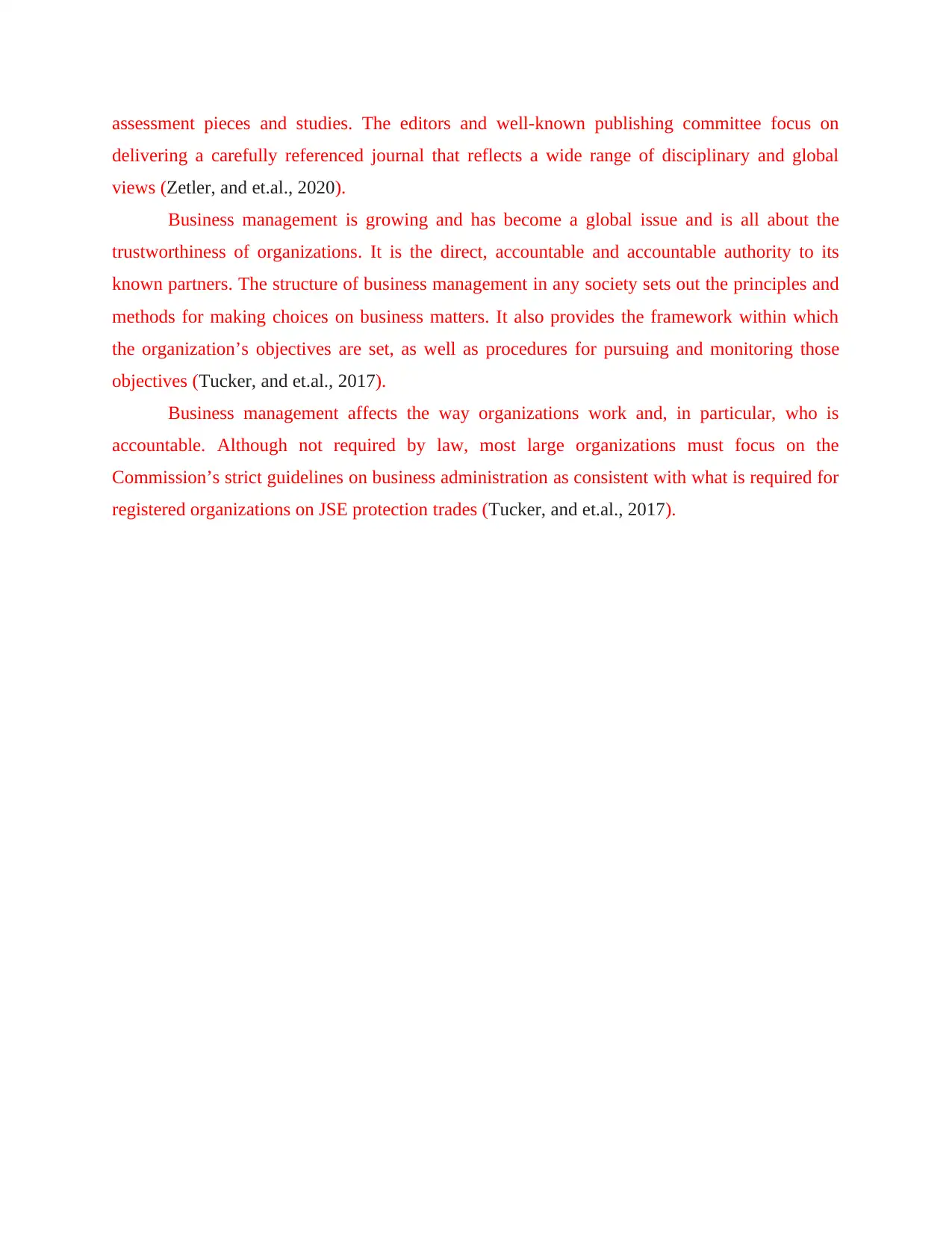
assessment pieces and studies. The editors and well-known publishing committee focus on
delivering a carefully referenced journal that reflects a wide range of disciplinary and global
views (Zetler, and et.al., 2020).
Business management is growing and has become a global issue and is all about the
trustworthiness of organizations. It is the direct, accountable and accountable authority to its
known partners. The structure of business management in any society sets out the principles and
methods for making choices on business matters. It also provides the framework within which
the organization’s objectives are set, as well as procedures for pursuing and monitoring those
objectives (Tucker, and et.al., 2017).
Business management affects the way organizations work and, in particular, who is
accountable. Although not required by law, most large organizations must focus on the
Commission’s strict guidelines on business administration as consistent with what is required for
registered organizations on JSE protection trades (Tucker, and et.al., 2017).
delivering a carefully referenced journal that reflects a wide range of disciplinary and global
views (Zetler, and et.al., 2020).
Business management is growing and has become a global issue and is all about the
trustworthiness of organizations. It is the direct, accountable and accountable authority to its
known partners. The structure of business management in any society sets out the principles and
methods for making choices on business matters. It also provides the framework within which
the organization’s objectives are set, as well as procedures for pursuing and monitoring those
objectives (Tucker, and et.al., 2017).
Business management affects the way organizations work and, in particular, who is
accountable. Although not required by law, most large organizations must focus on the
Commission’s strict guidelines on business administration as consistent with what is required for
registered organizations on JSE protection trades (Tucker, and et.al., 2017).

Conclusion
The demonstration and quality improvement intervention performed at the UK's Welfare Critical
Diagnostics Offices was paired with an update of the suppliers' vision of a reliable workplace
with the broker's focus on product, sourcing capabilities and get useful input. There is growing
recognition of the need to examine aspects of supplier management, particularly in light of
changes in wellness strategy. In application science, important result areas to study include the
appropriateness and adequacy of an intermediary (which appears to be "appropriate" in a
situation) based on suppliers, customers and various partners. participants, as well as deciding
how administrations can be offered at all scales. A positive workplace was identified which was
linked to the ranking of welfare personnel on the nature of care. Workplace arrangements,
principles and practices have advantages where a circle of assistance can be identified that is
helpful for wellbeing outcomes.
Problems monitoring the effects of wellbeing and changes in care and severity. Information
(with the exception except observational information from Public Health England London) and
data on how HIV care, silent understanding and changing needs in a mixed London have been
gathered in better places and now and then assembled from any part of the imagination. Due to
the heterogeneous nature of the most obvious textures and discontinuities, it is now hard for
anyone to truly understand how the whole pathway of HIV care is performing and where the
risks are.
The demonstration and quality improvement intervention performed at the UK's Welfare Critical
Diagnostics Offices was paired with an update of the suppliers' vision of a reliable workplace
with the broker's focus on product, sourcing capabilities and get useful input. There is growing
recognition of the need to examine aspects of supplier management, particularly in light of
changes in wellness strategy. In application science, important result areas to study include the
appropriateness and adequacy of an intermediary (which appears to be "appropriate" in a
situation) based on suppliers, customers and various partners. participants, as well as deciding
how administrations can be offered at all scales. A positive workplace was identified which was
linked to the ranking of welfare personnel on the nature of care. Workplace arrangements,
principles and practices have advantages where a circle of assistance can be identified that is
helpful for wellbeing outcomes.
Problems monitoring the effects of wellbeing and changes in care and severity. Information
(with the exception except observational information from Public Health England London) and
data on how HIV care, silent understanding and changing needs in a mixed London have been
gathered in better places and now and then assembled from any part of the imagination. Due to
the heterogeneous nature of the most obvious textures and discontinuities, it is now hard for
anyone to truly understand how the whole pathway of HIV care is performing and where the
risks are.
⊘ This is a preview!⊘
Do you want full access?
Subscribe today to unlock all pages.

Trusted by 1+ million students worldwide
1 out of 14
Your All-in-One AI-Powered Toolkit for Academic Success.
+13062052269
info@desklib.com
Available 24*7 on WhatsApp / Email
![[object Object]](/_next/static/media/star-bottom.7253800d.svg)
Unlock your academic potential
Copyright © 2020–2025 A2Z Services. All Rights Reserved. Developed and managed by ZUCOL.